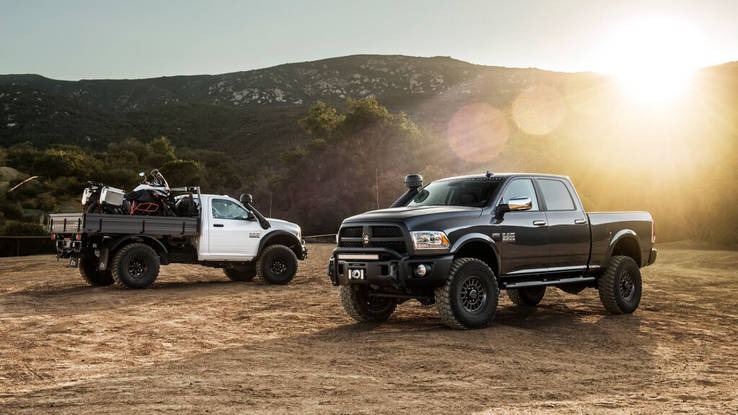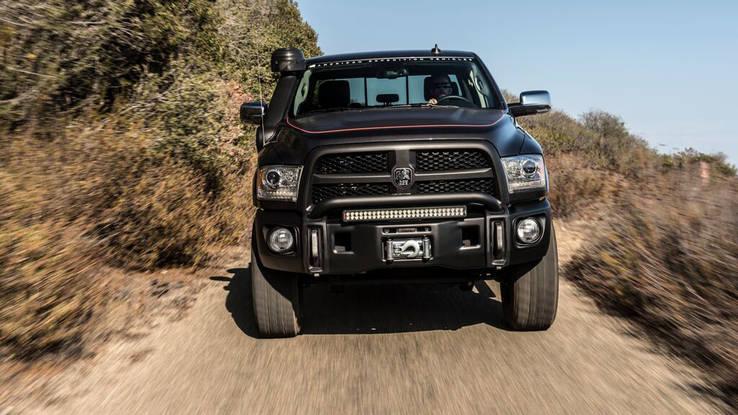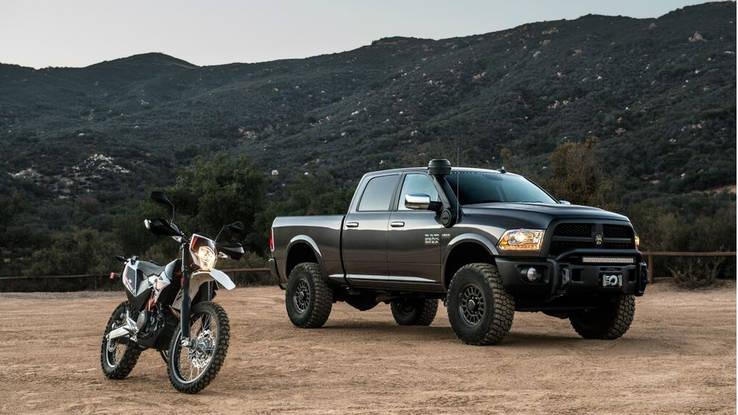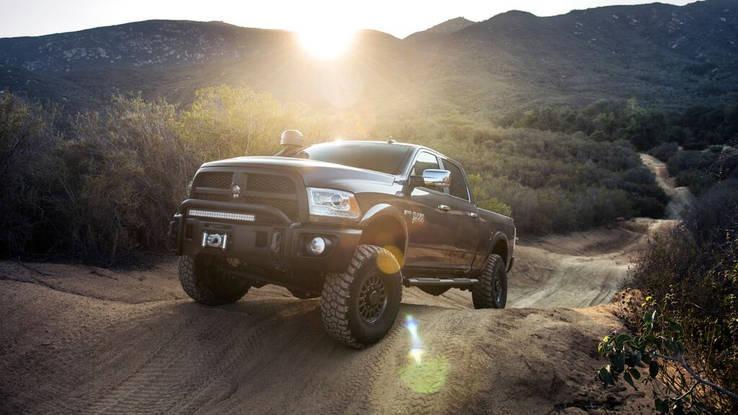A three-inch lift is just the beginning for this off-road monster
In those ads for active-lifestyle vehicles where there’s a guy running up a trail carrying a mountain bike over one shoulder and a kayak over the other, the guy could easily be AEV founder and president Dave Harriton. Harriton really likes that outdoor adventure stuff and built his business around getting to places to pursue it and bringing along everything a guy would need once he got there. His business, American Expedition Vehicles, is pretty big and very successful: It employs 100 people in a 100,000-square-foot facility upfitting Jeep Wranglers and other products.
But it wasn’t quite as simple as that. Let’s put it in reverse and back up a little.
Harriton grew up in the Pennsylvania Poconos, already a pretty scenic locale. But when it was time to go off to college, he hadn’t really done a lot of what statisticians call “research.”
“I wanted to go somewhere scenic and rugged but I didn’t have any idea exactly where,” he said. “While I was wondering what to do, this girl I sort of knew, a cute girl, said ‘I’m going to UoP, why don’t you go there?”
“I figured, University of the Pacific, that has ‘Pacific’ right there in the name, that must mean the Pacific Ocean, and the girl was going there…”
So he went. We’ve all made similar decisions based on sometimes even less reliable data. Turned out UoP was in Stockton, California, a small farm town with more troubles than most other big cities combined. Furthermore, it was nowhere near the Pacific Ocean and equally nowhere near the mighty Sierra Nevada mountains, both of which may or may not have appeared in a brochure somewhere. And finally, he never really saw the girl again.
“Maybe twice, just in passing,” he said.
Two years into a earning a degree in mechanical engineering from UoP, he’d had enough.
“So I started sending out applications to colleges that sounded like they were in cool, outdoorsy locations: Alaska, Wyoming, Montana…”
Montana replied.
“So I went there.”

We drove teh Ram 2500 on the right. At left is a concept diesel.
He switched from engineering to business, and for his senior entrepreneur project he proposed an aftermarket Jeep parts business.
“I had a Jeep that I was lengthening,” he explained.
Yes, lengthening. He wasn’t just jacking up the frame and adding bigger tires, though that was part of it. He was stretching the wheelbase. How many guys do you know who have stretched the wheelbase of their vehicles? To do that, he removed the body, cut the frame in half and added “just about the right length.” He had a AAA card that allowed him four free tows, which he used to get the frame to his friend with a welder, get it back to put the body on, and a couple other-mission-critical hauls around Missoula. It worked. When the Jeep was finished, he used it as an example for the aftermarket Jeep parts business. The idea was he would make parts to put on the Jeep and build a business around that, figuring that a lot of Jeep owners want to customize their rigs. He won the entrepreneur competition, got a loan for $ 35,000 using the Jeep as collateral, and started AEV, American Expedition Vehicles.
He now has a company making hundreds of turnkey upfit Jeeps, thousands of Jeep parts and now he’s branching out to Ram trucks, an example of which we were driving one day last week, hauling a pair of KTM motorcycles up into the mountains of Southern California to ride. On the way, Harriton described the business philosophy behind AEV.

If you see this in your rear-view mirror, pull over.
First, we all know there are plenty of aftermarket parts available. Lord knows there are aftermarket parts. But you may be surprised – shocked! – to find that many of them are cheap, underengineered and may make your truck wander around on the highway and roll over, whereupon you, hanging upside down from the three-point belt, will start to think, “Golly, maybe the aftermarket isn’t such a great place to attain the individuality and uniquely styled custom ride I so desired.” And in many cases you would be right. But not all cases.
Among the hundred or so employees working at AEV are an awful lot of engineers who used to work at Chrysler/Jeep/Ram. So they have a good grasp of the parts that make up your vehicle and how to improve them. And while AEV made its name on Jeep upfits, the expansion to Ram trucks was not only logical but inevitable.
“The biggest thing for us is that our products are real,” Harriton said. “Real products that function, first and foremost. Normally you have an aesthetic product and then you have a functional product. We go function first and then we make it look really good.”
He cited just one example out of hundreds, one part on the Ram Prospector we were driving.
“The tow hooks are cast nodular iron. They’re rated at 30,000 pounds, bolted directly to the frame, with a small amount of crush for front impact. If you look at a lot of the aftermarket bumpers, every one that we studied anyway, the tow mounts really aren’t up to the task of (pulling out) a diesel truck mired up to the frame in mud. One and a half GVW is what we test for. A direct 90-degree side pull we load-test at 18,000 pounds. Looking at the stuff that’s out there, it just wasn’t gonna hold up.”

The AEV Ram can haul all kinds of stuff, from campers to KTM 690 Enduro R dirt bikes.
He cited other examples.
“A lot of the aftermarket bumpers out there, didn’t have the proper cooling, they didn’t have enough air flow for the intercooler. Just another of the different issues that we test for.”
AEV’s testing replicates much of the same testing used by the OEMs, Harriton said, right down to hauling loads up the famous Davis Dam grade in the summer.
“We try and do things the way the factory did them. We want to mod these trucks so they’re better off road but we don’t want to ruin them. A lot of these lifted-up trucks, they lose a lot of stability, you don’t want to tow with them. They kind of become this useless, giant blob.”
Yikes.
“Typically an aftermarket company gives you some springs and some brackets and some fancy looking shocks and there you go, ‘Here’s your lift kit.’ On this kit everything is based around the stock springs. The reason is that on this Ram 2500 truck there are 44 different front springs from the factory and there are 18 rear springs. Those front springs are tuned to the rear springs and there’s millions and millions of dollars that went into engineering them. They’re tuned based on wheelbase and cab configuration… the difference is one’s for a diesel, one’s for a gas, one’s for a four-door, one’s for a mega cab, one’s for a 140-inch wheelbase, one’s for a 149-inch wheelbase…”
So while AEV does lift the truck and add bigger wheels and tires, it does it in conjunction with OE engineering. With coil springs at all four corners instead of leaf springs in back, the spring rates were calculated pretty precisely for each application.
“You can’t be perfect in every situation but you can get a bell curve where you get 90 percent of it. As an aftermarket company I can’t afford to have 44 different front and 18 different rear springs. The factory wouldn’t do it if they didn’t feel it was necessary. So when we set out to design our suspensions, we based it on the factory springs.”
There are a few accommodations. For instance, the front tires sit one inch farther forward to allow the larger diameter to fit better in the wheel well. But even that small difference is accommodated in the design.
“We added a new drag link that tricks the truck into thinking it’s stock, so every angle on the steering is stock, whereas on a lot of these lifted trucks the angles start changing, you start slowing down the steering rates and you start introducing bump steer and the roll center geometry is wrong and everything just changes for the worse. So we tricked the truck into thinking it’s completely stock. If you drive this truck and you drive a stock truck you’ll notice zero difference because the geometry’s exactly the same. So for a ¾-ton truck, these trucks ride just like the factory offering. The guy who does all of our suspension design and dynamics, he worked at Chrysler for well over a decade on the Cherokee, Grand Cherokee and the Liberty. He’s done Wranglers for the military. A whole buncha stuff.”

The sun never sets on the AEV empire.
And indeed, driving the truck on surface streets, freeways, twisting mountain highway and even steep, crawling off-road it felt just fine, with or without a motorcycle in back. On pavement the 37-inch BFGoodrich Mud-Terrain T/A tires were a little loud, but they’re off-road treads so the trade-off will be worth it once you get out in the swampy boonies.
Disconnecting the sway bars and putting it into four-wheel low was easy and from there it crept over any obstacle we could find. The 6.4-liter V8 Hemi seemed to have endless torque from idle on up and the 4.10:1 axle was so low we never even thought about hitting the lockers. The approach and departure angles, aided by the lift, were so steep we never scraped anything, except a little desert pinstriping on the sides of the cab.
Our truck had the full Prospector package, with everything from the 3/16-inch stamped steel bumper and Vision X Light Bar in front to the raised air intake with filter above. The basic Prospector Package, with the lift, front bumper, Salta HD wheels and tires is $ 13,925. As equipped, our truck had $ 16,120 worth of stuff, unless we missed an option or two.
Harriton said that his Jeep customers wanted something to haul a camper or tow a trailer and that the Jeep wasn’t as well-suited as the Ram. Now they are suited. As well as lifted.
You can get an AEV Ram or Jeep at your local Ram or Jeep dealer, probably, since AEV has deals with many dealers. You can also go directly to the source at www.aev-conversions.com or call 248-926-0256.





























